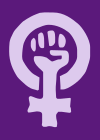
Back أرض المرأة Arabic Womyn's land French Tanah womyn ID ウィミンズ・ランド Japanese Women's land Dutch Womyn's land Portuguese خواتین زمین Urdu
This article has an unclear citation style. The reason given is: Per WP:CITEVAR: "If an article is already using a particular citation style you should follow it." (April 2019) |
| Part of a series on |
| Lesbian feminism |
|---|
 |
|
|
| Part of a series on |
| Radical feminism |
|---|
 |
| Women's liberation movement |
|
|
Womyn's land is an intentional community organised by lesbian separatists to establish counter-cultural, women-centred space, without the presence of men.[1][2] These lands were the result of a social movement of the same name that developed in the 1970s in the United States, Australia, New Zealand, and western Europe.[3] Many still exist today.[4] Womyn's land-based communities and residents are loosely networked through social media; print publications such as newsletters; Maize: A Lesbian Country Magazine;[5][6] Lesbian Natural Resources, a not-for-profit organisation that offers grants and resources; and regional and local gatherings.[7]
Womyn's lands practice various forms of lesbian separatism, an idea which emerged as a result of the radical feminist movement in the late 1960s.[8] Lesbian separatism is based on the idea that women must exist separately from men, socially and politically, in order to achieve the goals of feminism.[9] These separatist communities exist as a way for women to achieve female liberation by separating themselves from mainstream patriarchal society.[10] Men are not allowed to live in these communities, but a few lands allow men to visit.[4] Some communities ban male infants and/or male relatives.[4]
Womyn's lands have generated a wide range of criticisms, most of which centre around the lack of acceptance by many residents of bisexual and heterosexual women; the exclusion of transgender women; ideological conflicts with local communities that include violence and threats of violence targeting residents of womyn's lands;[11][12] and local community concerns about expanded lesbian visibility.[11][13] Examples of present-day womyn's lands include Hawk Hill Community Land Trust, HOWL, Susan B. Anthony Memorial Unrest Home (SuBAMUH) and Sugar Loaf Women's Village.[14] Today, these communities are facing decline as founders age, and they struggle to connect with younger generations of women.[4]
- ^ Levy, Ariel (March 2, 2009). "Lesbian Nation". The New Yorker. Retrieved April 26, 2017.
- ^ Ellison, Kate (September 30, 2013). "Lesbian Intentional Community: "Yer not from around here, are ya?"". Fellowship for Intentional Community. Retrieved 7 June 2018.
- ^ Cheney 1985.
- ^ a b c d Kershaw, Sarah (January 30, 2009). "My Sister's Keeper". The New York Times. Retrieved April 27, 2017.
- ^ "Maize, A Lesbian Country Magazine". Woman, Earth & Spirit, Inc. Retrieved 7 June 2018.
- ^ "Maize". Retrieved 13 June 2018 – via Lesbian Poetry Archive.
- ^ Waldner, Lisa K.; Dobratz, Betty A.; Buzzell, Tim, eds. (2004). "Rivers of ideas, participants, and praxis: the benefits and challenges of confluence in the Landdyke movement (by Sine Anahita)". Politics of Change: Sexuality, Gender and Aging (Research in Political Sociology, Volume 13). Emerald Group Publishing. pp. 13–46. ISBN 978-0762309917.
- ^ Bess, Gabby (October 13, 2015). "No Man's Land: How to Build a Feminist Utopia". Broadly. Retrieved April 26, 2017.
- ^ Shugar 1995, p. xi.
- ^ Shugar 1995, p. 14.
- ^ a b Cite error: The named reference
Lynchwas invoked but never defined (see the help page). - ^ Cite error: The named reference
Renowas invoked but never defined (see the help page). - ^ Greene, Kate (2003). "Fear and Loathing in Mississippi: The Attack on Camp Sister Spirit". Journal of Lesbian Studies. 7 (2): 85–106. doi:10.1300/J155v07n02_07. ISSN 1089-4160. PMID 24815896. S2CID 32627451.
- ^ Conti, Allie (December 18, 2016). "Who's Killing the Women's Land Movement?". Vice. Retrieved April 27, 2017.